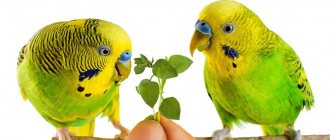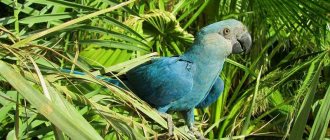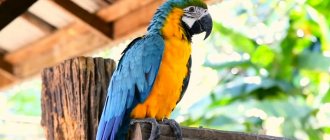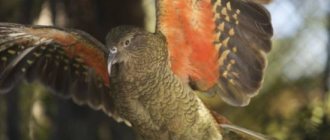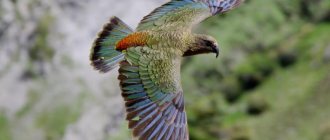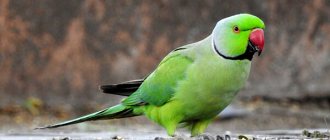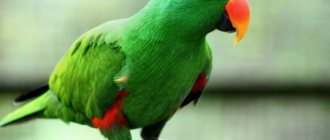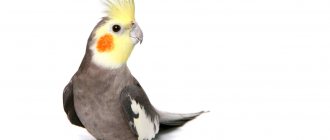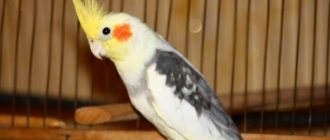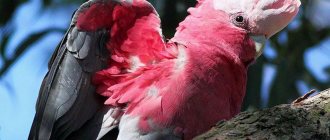The Corella parrot is a talking bird, related to the cockatoo. Initially, the gray-yellow color was enriched with various color options thanks to breeders. The expressive muzzle attracts the eye. The birds were equated to cockatoos due to the similarity of the body structure and crest. Later it was established that they belong to this family, but they constitute a separate species, the only one in the genus.
Everything about cockatiels: appearance, character, reproduction and nutrition in natural conditions, history of discovery - read further in the article.
About Corella parrots
This is what the Corella parrot looks like photo
The Corella parrot resembles a cockatoo in appearance, whose head is decorated with a beautiful crest. In the wild, their feathers are gray. This is what a cockatiel parrot looks like, you can see the photo above.
origin of name
— Advertising —
Photo of cockatiel
The homeland of cockatiels is Australia. This is how these feathered pets were dubbed by the indigenous inhabitants of the continent. Translated, this name means “like an eagle,” and most ornithologists are inclined to believe that cockatiels were the ancestors of eagles and hawks.
Interestingly, another name for the bird came from Europe. When travelers first saw these graceful birds, they mistook them for gray nymphs, who were considered by the Greeks to be eternally young goddesses of the life-giving forces of nature. Since then, scientists have called the cockatiel a nymph (Nymphicus hollandicus).
The first description of these Australian parrots was given by the Scottish naturalist Robert Kerr in 1793. And in 1840, the first individuals left the mainland on the ships of seafarers and conquered Europe with their appearance and charm. Since 1848, offspring began to be obtained from adult birds in captivity.
Appearance
— Advertising —
Appearance of cockatiel photo
The body of a medium-sized cockatiel parrot, including the tail, is 30 cm. At the same time, the pointed tail is half the length of the bird, and the weight rarely exceeds 100-120 g. You can see a photo of the cockatiel parrot above. The wingspan is from 30 to 35 cm. There are bright spots in the parotid area, and the beak has a neat shape and is slightly curved down, with visible plumage under the nasal openings. With good home maintenance and proper diet, the beak remains smooth, hard and shiny, without signs of delamination and wax growth.
At a young age, birds do not differ in plumage color. But then the males acquire a more saturated olive-gray color. The small head is crowned with a yellow crest. The color of the female's plumage, legs and rings surrounding the eyes remain gray, but the crest and head have a yellowish tint, and the top of the tail and the lower part of the back may be covered with brown pigment. The eyes of cockatiels always remain dark brown, and there are round orange spots on the cheeks that distinguish this bird from other cockatoos.
Corella is a songbird with a rather melodious voice. They sing well and also easily parody human speech, the sounds of household appliances and pets.
The variety of colors is due to the artificial breeding of cockatiels, since it is currently prohibited to export these birds from Australia. Breeders have bred more than 20 species of cockatiels of a wide variety of colors. In addition to colorful parrots, you can also find black and white nymphs.
Origin of the species and description
Photo: Corella parrot
The first parrots appeared approximately 55-60 million years ago - after the extinction that occurred at the end of the Cretaceous period. Then most of the organisms inhabiting the planet disappeared and, as always after such cataclysms, the surviving species began to change and divide to fill the vacated ecological niches.
The earliest fossilized remains of parrots were discovered in Europe - at that time its climate was tropical and perfect for these birds. But modern parrots did not descend from their European line - it is considered completely extinct - but from another branch.
Video: Corella
How the development of parrots took place has not yet been established clearly enough, although as more and more fossil remains are found, the picture becomes more and more complete - it is interesting that all early finds occur exclusively in the northern hemisphere, although modern parrots live mainly in the southern hemisphere.
It has been established that the part of the brain that allows parrots to imitate other people's sounds, such as human speech, appeared about 30 million years ago. Strictly speaking, before the parrots themselves - approximately 23-25 million years have passed since the emergence of the first modern species.
These fossils can already be clearly identified as corresponding to modern cockatoos, presumably the oldest surviving species of parrot. Most of the others happened much later. The genus and species of cockatiel belong to the cockatoo family. He received a scientific description in 1792, made by the British zoologist R. Kerr. The species name in Latin is Nymphicus hollandicus.
Behavior and diet
The photo shows a gray and white cockatiel.
Corellas love to watch people's actions and are easily involved in games; they are very active and curious. However, to maintain such energy, birds need the right diet.
In the wild, parrots prefer the leaves of eucalyptus trees and shrubs, juicy fruits and herbs. They also love nectar, seeds, resin and young bark of many woody plants.
At home, they should receive a similar diet. It should include fresh vegetables, fruits, herbs and grains. Occasionally it is necessary to add a boiled egg and low-fat natural cottage cheese to the food.
How to tame a cockatiel?
It’s easy to tame a cockatiel, the main thing is to be patient and give the parrot enough attention so that it gets used to your company. It is quite natural that your feathered pet will not immediately feel comfortable in a new environment. Do not bother the parrot in the first few days after moving in, give it time to calm down and look around. This way he can quickly get used to the new environment. Then you can start communicating with your pet. At first, try to limit the access of other pets to where the cockatiel is.
To tame a cockatiel, the bird must trust you. Don't try to force her out of her cage. Try feeding your pet from the palm of your hand, handing it some kind of treat, calmly and affectionately repeating the bird's name. Try not to make sudden movements and make sure that your palms do not have any foreign odors.
If everything is done correctly, the Corella parrot will feel safe and after a while will become completely tame. Taming a cockatiel will not be difficult, because it is an active, sociable bird that loves attention to itself. Don't forget to communicate with your pet to make him feel happy.
The Corella parrot is a kind, naive and open bird, which is not characterized by aggression. If suddenly a cockatiel parrot begins to bite, then this is a signal that something is wrong with it. Perhaps the bird is stressed, he is sick or he doesn’t like something. By biting the parrot is trying to tell about any problems. Try to recognize what's wrong. Do not forget that the cockatiel does not like strong odors such as tobacco, air fresheners and perfumes, as well as loud sounds, which frighten her very much. If the reasons have not been identified, and the bird’s behavior does not change for the better, then you should seek help from a veterinarian.
Habitats
Photos of gray cockatiels
Nymphs are indigenous to Australia. Their main habitat is eucalyptus groves in river floodplains, as well as fertile steppes, in which there are enough solitary trees and tall shrubs. Small groups of cockatiels live in semi-deserts.
During the breeding season, cockatiels break into pairs, hatch chicks and take care of their offspring. The rest of the time they unite in flocks of 10-15 individuals. If the year is excessively dry, parrots move in large numbers closer to bodies of water.
On other continents, cockatiels are not found in the wild, although they are very popular to be kept instead of budgies in North America, Asia, Europe and in our country. Domestic parrots that fly away from their owners are not able to survive in the wild on their own. Therefore, you need to ensure that feathered pets do not have the opportunity to fly out of windows or doors into the street.
Social structure and reproduction
Photo: Talking cockatiel parrot
School birds live in groups; they can consist of a very different number of cockatiels, from a dozen in the smallest ones, to a hundred or more in the largest ones. A little more than a hundred cockatiels is the threshold value, after which it becomes difficult for the flock to feed, and it splits into several. In poorer areas this value may be smaller, and then division occurs when the flock grows to 40-60 parrots. Sometimes cockatiels can even live in small families of just a few individuals in each - but usually a dozen of these families occupy trees in direct line of sight from each other, so that they can all be considered one group.
The breeding time for cockatiels comes with the beginning of the rainy season, because food becomes more abundant. If the year turns out to be dry, they do not reproduce at all. For nests, they choose voids between thick branches of old or even completely withered trees. There are 3-8 eggs in the clutch, which need to be incubated for three weeks - both parents do this alternately.
The newly hatched chicks have no feathers at all, only yellow fluff, and fledge only after a month. After hatching the chicks, the parents feed and protect them, and continue to do this even after they learn to fly and leave the nest - after all, they remain in the flock, and the parents know their own. Guardianship continues until the moment when the young cockatiels reach adult size and have their own children. The chicks leave the nest a month and a half after birth, after which their parents immediately lay a second clutch - usually the first occurs in October, and the second in January.
This is the most stressful time for them - they must first hatch the eggs, and then feed the next chicks, and at the same time continue to take care of the previous ones. Although in nature their nests are located high, when kept in captivity the nesting house can be hung at a low height. It should be quite spacious - 40 cm high and 30 cm wide. The bottom is covered with sawdust - you need to put more of them. It is important that the room is warm and light, and more food should be given at this time, otherwise the laying will not be done.
Migratory or wintering
The photo shows a yellow cockatiel on a branch.
Corellas are capable of covering considerable distances, but they are not migratory birds. In winter in Australia, the thermometer does not drop below 0°C, so birds can easily cope with this time of year. In addition, winter is considered the rainy season, when plants receive sufficient moisture and increase their growth, providing food for birds.
Cockatiels were forced into Europe on ships, but not a single bird left Australia on its own.
A little history of the species
The homeland of cockatiels is Australia. Animalist and ornithologist John Gould undertook a zoological expedition to the mainland in 1838–1840. He took out about eight hundred birds and seventy animals. Upon returning to Great Britain, the scientist systematized his works, the result of which was the book “Birds of Australia”. In the part dedicated to parrots, the ornithologist tells everything about cockatiels: their lifestyle, appearance.
Europe first saw cockatiels in the forties of the nineteenth century. From Paris, the birds, through the efforts of private breeders, spread throughout the European part of Eurasia. After 1960, Australia introduced a ban on the export of parrots outside the country. Further breeding and selection took place without the participation of wild representatives.
Species (subspecies)
Photo of a light gray cockatiel
The only species of cockatiel that lives in natural conditions has a light gray or dirty gray color. But thanks to breeders, new varieties of nymphs of different colors were bred in captivity. Currently, there are eleven main color variations of cockatiels, and some even have their own subspecies.
Albino Corella
Photo of an albino cockatiel.
A distinctive feature of this species is the white color of the plumage of the female and male and red eyes. A slight creamy coating is allowed, but the yellow color of the head feathers and crest is retained.
Males always have snow-white feathers, but females may have slightly yellowish spots on the wings and under the tail, which create a marbled effect.
To produce albinos, breeders crossed lutino with parrots that have a white head.
The albino cockatiel subspecies includes the white nymph, which has black eyes and a clearly visible yellow coating on its plumage. Interestingly, the two longest tail feathers in males are snow-white in color, while the rest remain slightly yellowish. In females, the tail is yellow and the undertail is marbled. When obtaining this subspecies, they were used to cross white females and gray males, who are carriers of the whiteness gene.
Lyutino
Photo of Corella Lutino
Corella Lutino is characterized by red eyes and deep yellow feathers. In adults, the eye color changes to dark cherry. There is spotting on the wings and back, but the color contains only various shades of yellow, which determines the name of the species.
On the light yellow plumage of the dewlap there is a kind of ladder of more clearly visible spots. This is considered a disadvantage of the breed, so breeders are looking for crossbreeding variations that will make it possible to get rid of it.
In male lutinos, the “blush” on the cheeks must be orange.
Sheki
Photo of Sheki cockatiel
Sheki are the most popular and expensive varieties of cockatiels. They are distinguished from other species by the presence of white spots on gray feathers. The symmetrical arrangement of spots, as well as the presence of gray and white in equal proportions, are especially appreciated.
Sheki have gained great popularity among breeders, as they are recognized as the best source material for breeding new subspecies. An example of this breeding is the Pearl Neck, which has an all-white head, a yellowish-tinged tail, and iridescent gray feathers on the back and wings. Interestingly, in adult females the color remains even after molting, while in adult males the color changes to the classic shek.
Among this subspecies of nymphs there are “harlequins” with gray wings, a yellow head and crest feathers. The rest of the body, neck and legs are white.
Cinnamon colored cockatiel
Photo of a cockatiel with a brown tint.
In the body of parrots, under the influence of enzymes, a black pigment is formed. Due to the failure of biochemical processes, the cinnamon-colored nymph produces more of these enzymes than the gray-colored cockatiel. As a result of crossing them with lutino, individuals with varying degrees of intensity of brown color are obtained.
From birth to 3 months, the eye color of the chicks remains red and then darkens. In adult birds, the beak and pink feet also gradually become darker.
In addition to the varieties described, the following subspecies of nymphs are distinguished:
- black;
Photo of black cockatiel
- light and pearl gray;
Photo of a light gray cockatiel
- dark yellow;
Photo of dark yellow cockatiels
- white- and black-winged.
Photo of a white-winged cockatiel
The appearance of offspring in a cockatiel
The cockatiels take turns incubating the eggs and feeding the chicks. Typically, males incubate the eggs during the day and females incubate them at night. By the time the chicks begin to be born, the female sits more on the eggs.
Corella chicks are born covered with thick yellow down. When demanding food, they make an unpleasant sound, so those owners who plan to breed cockatiels need to be prepared for the fact that this will hurt their ears.
When the last chick is born, the cockatiel's parents leave the nest often enough to get food for intensive feeding of the fledgling babies. When they fly away at night, the chicks remain in the nest, huddled closely together, thereby keeping warm. At the age of two weeks, they are overgrown with dense gray down, and their wing covers partially open.
At the age of 35-40 days, cockatiel chicks leave the nest for the first time. At this time, they are already feeding on their own, can sit down and hold on to a perch, flap their wings and try to fly around the cage.
Corella parrots feed their babies from 2 weeks to two months of age. Often the female immediately starts the next clutch and stops feeding the chicks. In such cases, young nymphs need to be removed and fed artificially.
At the age of 4-10 months, young cockatiels begin their first molt, which lasts about five weeks. After this, you can determine the sex of the parrot. The difference between a young male and a female is that the “boys” try out their voices and sing melodic songs, while the “girls” do not do this.
Female and male
The photo shows a female and a male cockatiel.
Sexual dimorphism in cockatiels is weakly expressed. The male Corella is colored in richer shades and has distinctive white stripes on its wings. The plainness of the female’s coloring can only be noticed in comparison with an individual of the opposite sex. She also has transverse pale yellow stripes on her tail, and oval spots of the same color can be found on the inner surface of her wings. Young individuals retain the same color as their mother until the completion of the juvenile molt. However, after molting at 9-12 months, it changes in males.
In cockatiel chicks, sex can only be determined by behavioral reactions. Adolescent males sing loudly, bang their beaks on hard surfaces, straighten their shoulders and stomp, trying to attract the attention of females. Those, in turn, behave modestly, take a low posture and throw back their heads, showing their readiness to submit to the male.
Video “Corella bathes”
A funny video showing how to bathe a parrot.
Was this article helpful?
Thank you for your opinion!
The article was useful. Please share the information with your friends.
Yes
No
X
Please write what is wrong and leave recommendations on the article
Cancel reply
Rate the benefit of the article: Rate the author ( 8 votes, average: 4.00 out of 5)
Discuss the article:
Keeping at home and breeding
Photo of a yellowish cockatiel sitting on a glass
Despite the fact that a hot climate prevails in the homeland of cockatiels, it is best to maintain the room temperature from 18 to 25°C. Even a temporary decrease in indicators to +10°C will not have detrimental consequences for the health of the bird. However, exposure to frost or draft will quickly lead to illness or death of the nymph.
The average daylight hours should be 14 hours in the warm season, and 10 hours in the cold season. It is also useful for cockatiels to turn on a UV lamp.
Information about cockatiel parrots when kept at home
and a Gray-yellow cockatiel sits on a branch photo
In order for your feathered pet to quickly get used to its new place of residence, you must choose and equip its cage correctly. For one bird, the dimensions should not be less than 50x40x60 cm. For a pair of nymphs, larger cages are needed, measuring 150x60x90 cm.
It is advisable to release parrots daily so that they have the opportunity to fly freely and walk around the house for 1.5-2 hours. If this is not possible, you should purchase a cage in which the birds can fly from place to place.
The bars of the cage should not be painted, since paint can cause poisoning if it enters the bird’s stomach. Inside, the nymphs' home should be equipped with several perches, feeders and drinkers attached to the walls. It is advisable to hang “bird” toys, a mirror and a bell. At the bottom you should put branches of woody plants treated with boiling water and place a bowl with sand.
Corellas love to swim, so you need to put a bathing suit with water in the cage. Clean up as it gets dirty, promptly discarding droppings, fallen feathers and leftover food.
How to feed your pet cockatiel
In the photo, a female and a male cockatiel are feeding on a mineral stick.
To provide the cockatiel’s body with a sufficient amount of energy and maintain health, you should give them succulent and grain-based foods, and also periodically introduce vitamin and mineral complexes into the diet.
Grain mixtures must contain the following components:
- millet;
- oats;
- corn;
- wheat;
- sunflower seeds;
- flax seeds and weeds.
It is best to purchase balanced special food intended for parrots in specialized stores.
Corellas love juicy fruits and berries. Citrus fruits and unroasted nuts can be given occasionally. Among vegetables, nymphs prefer zucchini, carrots, and pumpkin, and among greens, lettuce, spinach, young shoots of dandelion and beets.
For protein foods, you should choose low-fat cottage cheese and hard-boiled eggs. In the autumn-winter period, nymphs should be given branches of pine needles and rowan 2 times a week.
Breeding information
Photo of a gray-yellow cockatiel
Corellas can easily reproduce at home if they are provided with proper care and nutrition. The optimal breeding period is from May to October. Only healthy birds with no visible signs of disease should be brought together. A special house must be placed in the cage, where the females build nests and lay eggs.
Parents alternately warm the clutch of eggs, from which chicks emerge after 20-23 days.
In the first days of life, females feed the chicks with “fore stomach milk”, which is a yellowish liquid. On the 3-4th day, they begin to feed the cubs solid food, which they first swallow, partially digest, and then regurgitate. After 2 weeks, babies can absorb small pieces of food on their own. And by the beginning of the second month of life, they leave the nest and try to fly.
During the breeding period, difficulties with the health of the female and babies may arise, so as an alternative, you can buy a chick from an experienced breeder.
What does a cockatiel eat?
Photo: Corella parrots
The diet of this parrot in nature includes:
- seeds;
- cereals;
- fruits;
- nectar;
- insects.
In the wild, they prefer to feed on the seeds or fruits of fruit trees; they are also not averse to enjoying eucalyptus nectar - when these trees bloom, you can find many cockatiels on them. They settle near a source of water because they often need to quench their thirst. Sometimes they can act as a pest: if there are agricultural lands nearby, flocks of cockatiels visit them and peck off cereals or fruits. That’s why they often don’t get along with farmers. In addition to vegetation, they also need protein food - they catch and eat various insects.
In captivity, the cockatiel is fed mainly with grain, but it is important that the parrot’s diet is balanced in terms of protein, fat and carbohydrates, contains a number of vitamins, and finally, you should not overfeed your pet - 40 grams of food per day is enough for him. Usually the bird is fed mainly with grain mixtures or sprouted grains, but some green vegetation should be added to them. For example, celery, spinach, corn, dandelion and tree branches - spruce, pine, linden, birch - are useful. The cockatiel can also feast on buds and nuts.
Fruits and vegetables are an obligatory part of the cockatiel menu. Almost any is suitable for them: apples, pears, pineapples, bananas, peaches, cherries, watermelons, citrus fruits, berries from raspberries and strawberries to rosehips and rowan berries. Almost all of the vegetables grown in our gardens are also suitable: cucumber, carrots, beets, turnips, zucchini, eggplant, peas, pumpkin, tomato.
It is worth giving only one type of vegetable at a time, but over the course of a month it is better if the bird’s diet is varied - this way it will receive more different vitamins. It is advisable to hang bird chalk in the cage, and put additives intended for parrots in the food. Finally, she needs to be given some meat, milk, cottage cheese or eggs. In addition to eggs, you can feed your cockatiel cookies, but you should keep in mind that you cannot give food from your own table: sometimes parrots eat them with appetite, and then it turns out that it is harmful for them. A pet may even die if there is something harmful to it among the ingredients.
Now you know what to feed your cockatiel parrots. Let's see how these birds live in the wild.
Interesting Facts
Photo of a cockatiel on a cage
There are several interesting facts that colorfully characterize cockatiels:
- The nymph's intelligence is identical to the mental development of a 3-4 year old child.
- A parrot raised in captivity becomes completely tame, considering a person a member of its family.
- In the wild, a cockatiel sitting on the ground will not allow a person to approach it, but when it is on the branches of trees, it can safely allow people to touch it.
- Nymphs recognize about one and a half hundred different images per second, while humans recognize only 16.
- There are schools in Australia that teach cockatiels and other parrots to talk.
- Nymphs do not have vocal cords, and they produce sounds only with their mouths.
- Depending on which paw the cockatiel takes food with, it can be considered right-handed or left-handed.
What to look for when choosing a cockatiel
- If you need a parrot for entertainment, then you need to choose a young bird, about a 5-6 week old chick. You need to spend a lot of time with her so that she gets used to you faster. If you cannot communicate with the bird often, then choose a female or male for it.
- When choosing a cockatiel, you need to watch it. A bird that sits ruffled, with its eyes closed and on two legs, is most likely sick. Examine her ears, lift the feathers, there should be no signs of inflammation.
- In a good bird, the chest frame cannot be felt. If the chest contour protrudes, it means the bird was poorly fed, and this will lead to the development of various diseases.
- The cockatiel's feather cover should be uniform, without signs of tuft loss. If the feathers do not fit tightly and stick out, the parrot is infected with parasites.
- The bird's anus should be clean and free of redness.
Singing
Both in natural and at home conditions, the cockatiel sings very melodiously, accurately repeating the sounds it hears. Nymphs easily copy the sounds of alarm clocks, household appliances and other pets. But teaching them to talk is a little more difficult. To do this, you need to show self-control and patience.
Male cockatiels sing especially beautifully during the mating season. At this point, it is easiest to teach the cockatiel to repeat sounds, as well as melodies. To do this, you should hum or whistle simple songs several times a day.
Intelligence and character
All types of cockatiels are recognizable due to their unpretentious and friendly personality. Birds get along easily with humans and are smart conversationalists. It is not their behavior to be aggressive towards people or their own kind. They quickly learn individual words and phrases and are able to remember melodies (the opposite of a lovebird).
The optimal vocabulary of a cockatiel is 200-300 words. Like any animals and birds, cockatiels can be trained using the gingerbread method. They reproduce with detailed accuracy the sounds of household noise, such as opening a door, a doorbell, or a telephone. In this they are similar to their closest cousins, the cockatoo, the rosella or the Indian necklace.
In order to teach a Corella to speak, you need to buy a chick in childhood and it is best that it is immediately accustomed to being handled. They remember well the sounds with which they associate a certain room, time or action. If you tell your pet a story, the cockatiel will forget it the next day.
For example, the phrase “Good morning” is said only before feeding. If you repeat it repeatedly throughout the day, she will simply say it mindlessly. For every attempt, even if it’s not clear, reward him with a treat or a pat on the neck.
The Corella parrot remembers its name faster with the accompaniment of voicing actions (Kuku eats, Kukku goes to bed, etc.). Parrots are very affectionate towards their owners and treat them as members of the flock. Males, as a rule, are more active than females, whistle and their chirps are more melodious. Breeding requires extreme caution and attentiveness on the part of the owners. If the very nature of pets is kind to humans, this does not mean docile behavior when there are a large number of birds in a confined space.
Owner reviews
We chose between a budgie and a cockatiel. We did not regret the choice we made. The parrot easily makes contact with children. They entertain each other and don't bother me
Elena, Ekaterinburg
Picky and friendly birds. The cage left from the budgerigar is too small. I had to buy a new bigger one. The parrot is clean and not picky about food. I'm happy with the purchase.
Victor, Shakhty
Everything would be fine, and the children are happy, but she screams simply in horror. It will wake you up in the morning, won’t let you read in silence during the day, and by the evening it won’t calm down. I'd rather buy a canary
Anna, Moscow
A beautiful, vocal and smart bird. Freezes as soon as the temperature drops below +20°C. In our conditions, additional lamps were required as a heat source. In general, it’s ok, the children are happy
Alena, Nizhnevartovsk
There's a lot of garbage from it. I laid down sawdust, and within a day almost all of it ended up on the adjacent cabinets. Well, at least they didn’t recommend sand. He even throws out toys and chews out a wooden cage.
Marina, Kislovodsk
My wife developed an allergy to down and feathers, and not immediately, but only after a month. I had to give it to friends. And the bird itself is interesting, smarter than a budgie
Alexander, Kolomna
Buying poultry for your home
The younger the bird, the easier it is for it to adapt to new conditions. The optimal age for moving to a new owner is 3-3.5 months. The young animals are already quite old and do not depend on their parents: they feed and serve themselves.
What to look for when choosing a chick
First of all, it's appearance. The plumage should be laid evenly and have a glossy appearance. Growths on the beak and paws, watery eyes, indicate problems with parasites or other pathologies. If the chick chirps cheerfully, is active and plays with its fellows, then most likely everything is fine with it.
Males are noticeably easier to train and are interested in training, while females are more sociable and playful.
Price
The average cost of a bird ranges from 1500-4000 rubles , which depends on its subspecies, age and availability of veterinary documents. The latter indicate the vaccinations given and the results of laboratory tests.
Where is the best place to buy
The ideal option is from professional breeders. Buying a cockatiel at the poultry market from private individuals is a big risk. The parrot may turn out to be sick and wild, which greatly complicates the animal’s adaptation to a new place.
How much does Corella weigh?
An adult cockatiel is similar in weight to a small pigeon. The normal weight is 100 grams. However, each individual representative of the breed is individual and can develop in its own way. Individual individuals can weigh either 80 grams or 150.
Weight largely depends on the conditions of detention and nutrition. Too small indicates that the Nymph is sick or malnourished. Overweight is also not considered normal, since such birds suffer from obesity.
Normal weight of a parrot
What to name a yellow parrot
Male cockatiels can be called talkers. These birds love to imitate and imitate the sounds that they often hear around them.
If you want to teach your feathered pet to say its name, you should pay attention that the name of the parrot must contain:
- hissing - w, w, shch;
- deaf - k, f;
- calls - d, g, r;
- vowels - a, i, e, u.
Learn how to tame a cockatiel and how to teach it to talk.
The name should be easily divided into syllables to make it easier to remember and speak. However, you should not choose nicknames that are too long, consisting of many syllables.
This set of letters is easily perceived by cockatiels, and birds have no difficulty in reproducing it. Universal nicknames for cockatiels include: Arnie, Basie, Dezzy, Kiki, Ricky, Roni, Chuchi.
girl
Female cockatiels lutino are most often called by the following nicknames:
- Asya, Assol, Ava, Aisha, Argo, Arina, Arisha, Asha;
- Bassy, Belka, Bertha, Betsy, Bibi, Bisha, Blanche, Britney, Byasha;
- Varya, Venus, Verka, Freckles, Vicky, Virra, Vlada;
- Gamma, Galya, Glasha, Gyurza, Gressi;
- Dana, Jela, Julie, Dinara, Disa, Dera;
- Eva, Yolka, Yoshka;
Learn how to make a cockatiel cage.
- Jojo, Jolly, Zhulka, Zhumka, Zhurra;
- Zara, Zena, Zina, Zlata, Zora;
- Ida, Inga, Irma, Irene, Ircha;
- Karella, Kasia, Katya, Kiwi, Kira, Kreida;
- Larra, Libby, Lima, Lyra, Luna, Lusha, Lushka;
- Mackey, Manya, Marisha, Masha, Mirra, Michelle, Maggie;
- Nami, Nellie, Niko, Mink, Nyusha, Nyama;
- Oda, Okki, Onika, Oriva, Ophelia;
- Panny, Peggy, Pitta, Perry, Pusya;
- Rada, Raya, Rozzi, Ruta, Rady;
- Saga, Sarah, Cindy, Sonya;
- Tanya, Thames, Tumka, Tyushka;
- Unka, Ulya, Urma, Ursula, Ustya;
- Fanka, Fairy, Frezi, Frosya, Fury;
- Hanni, Hasya, Hirra, Chloe, Juana, Hella;
- Tsatsa, Tsea, Zinnia, Tsypa;
- Chana, Chacha, Chilita, Chunya;
- Shani, Shella, Sherry, Shusha;
- Ellie, Elsa, Emma, Erica, Estha;
- Yucca, Yurga, Yusya, Yutana, Yusha;
- Yaba, Yazi, Yanka, Yashi, Jasper.
Did you know? In Australia, special schools have been created for chirps. They teach parrots to talk.
What diseases can a bird have?
Just like other feathered cockatiels, they are susceptible to infectious, bacterial and fungal diseases. Moreover, birds often become carriers of fleas, ticks and lice. We cannot exclude genetic pathologies, which cannot be cured in principle.
Common diseases in cockatiels:
- parasitic insects;
- sinusitis;
- conjunctivitis;
- problems with the gastrointestinal tract;
- feather loss;
- heart diseases;
- worms.
At the first signs of illness, it is better to go to the clinic rather than self-medicate.
Nutrition
In the wild, representatives of the breed consume cereals, grass, seeds, nuts, and fruits. They drink water on the fly, taking several sips from the surface of rivers.
It is better not to give human food to poultry, as there are many ingredients that are harmful to them. Corella is more suitable for special fresh food, vegetables and fruits. They can eat boiled eggs and cottage cheese as sources of protein.
What does a cockatiel eat?
The nymph can be given small amounts of sunflower seeds, soaked beans and wheat. Freshly cut grass will be a good treat. During the nesting and molting period, Cockatiels need additional nutrients, which can be given in the form of liquid vitamins.
How to teach a cockatiel to talk?
Teaching a cockatiel to speak is very simple. After all, a cockatiel is a talking parrot that can learn up to 300 words. The main thing is to take time and be patient. You should start training only after the pet has settled into its new home and you have established contact with it. Choose a word to learn. It is best that the first word you learn is the name of the parrot.
To teach your cockatiel to speak, you need to pronounce a word or phrase clearly and evenly. You should not speak too loudly, as this may frighten your pet. During training, be sure to look at the parrot, so he will understand that he is being addressed. Dedicate no more than half an hour a day to such activities, just try to do them at the same time.
To teach your cockatiel to speak, it is very important to maintain regular training, as the result depends on this. Also remember to praise your parrot and reward him with treats. Believe me, the result will not be long in coming, and your pet will soon delight your ears with the word it has learned. Be careful and try not to use swear words around the parrot, otherwise he will please you with this too.
If, while bathing or feeding the cockatiel, you repeat a phrase that characterizes the action, then the bird will sooner or later comment on the event itself. The cockatiel can also sing and repeat the melodies it hears. For example, she might repeat a cell phone signal that she hears frequently.
The nymph parrot is unique in that it can both speak and sing. You can choose a song and play it for your parrot every day. This way the cockatiel will quickly learn the melody and will soon perform a familiar tune. As you can see, teaching a cockatiel to talk is easy.
Lifestyle
Wild representatives are always part of the pack. They are very energetic and rarely stay in one place for long. Nymphs walk quickly on the ground, spend long flights, and climb tree trunks well.
Read also
Can budgies have fleas
Birds prefer to rest on the upper parts of old eucalyptus trees. This is due to the fact that, thanks to their gray color, they can easily camouflage themselves in dried branches. But Corellas are very trusting and, when they notice people, they allow them to approach them. Thus, they often become prey for hunters.
Domesticated Nymphs do not require special conditions of detention.
Cockatiel lifestyle
The standard set for all parrots is enough for them:
- wide cage with the necessary equipment;
- suitable microclimate;
- the ability to fly around the room;
- constant communication;
- timely treatment;
- balanced diet for Corella;
- pure water;
- regular cage cleaning;
- safety;
- the opportunity to interact with other birds.

